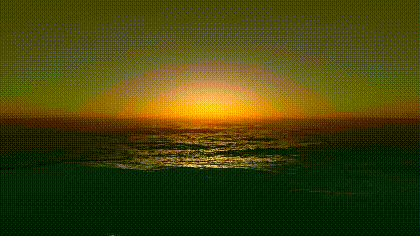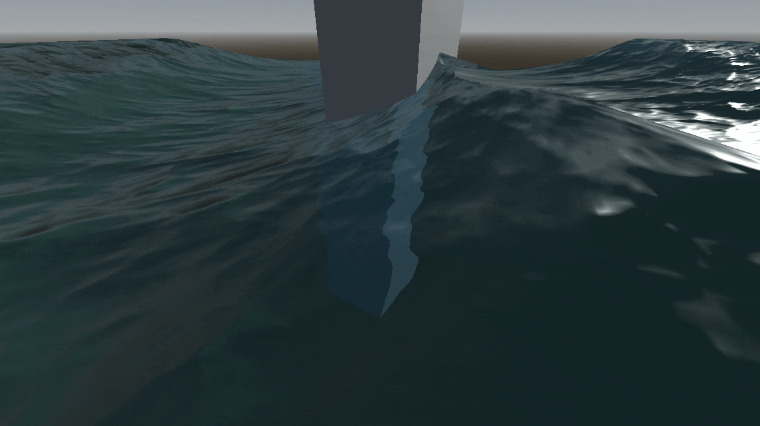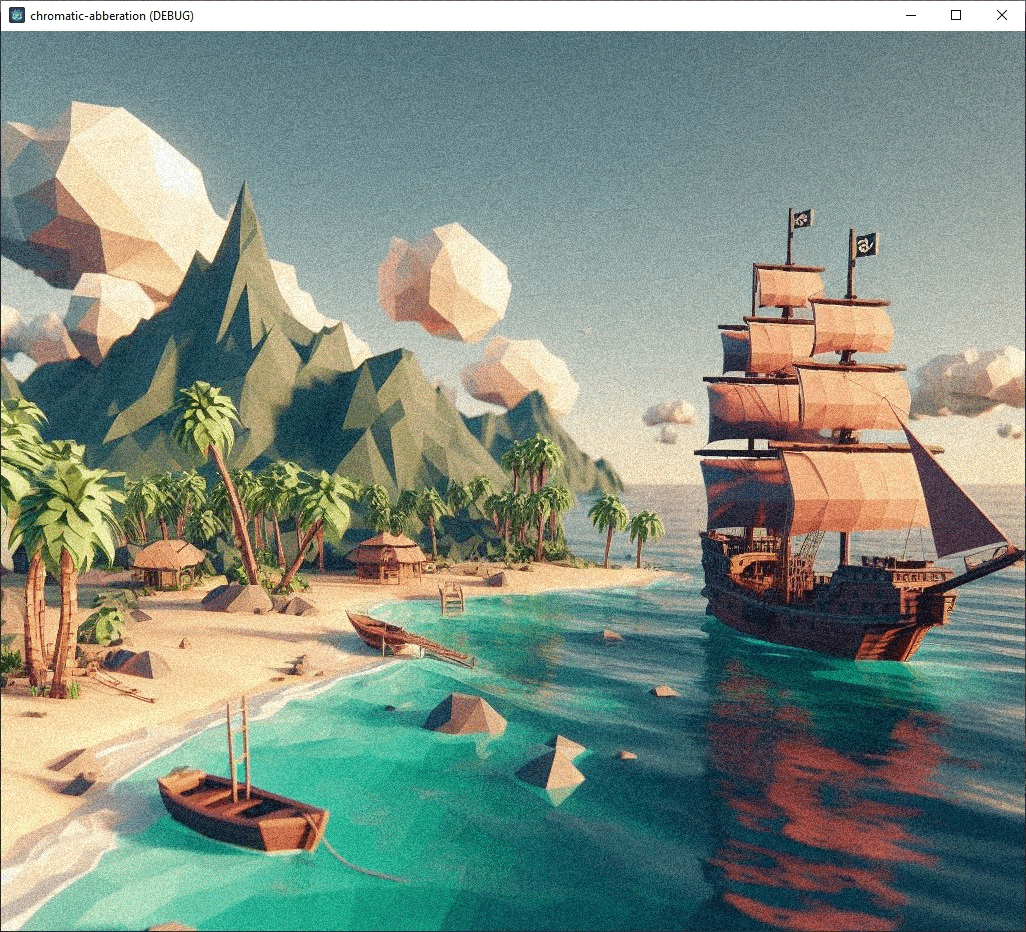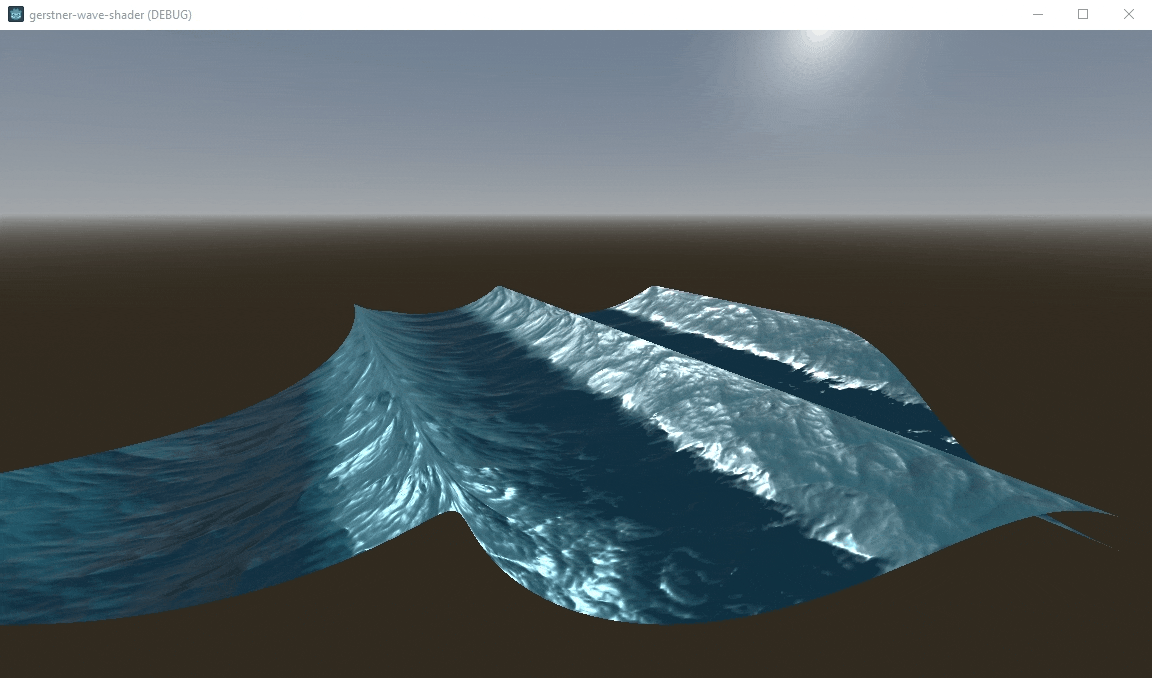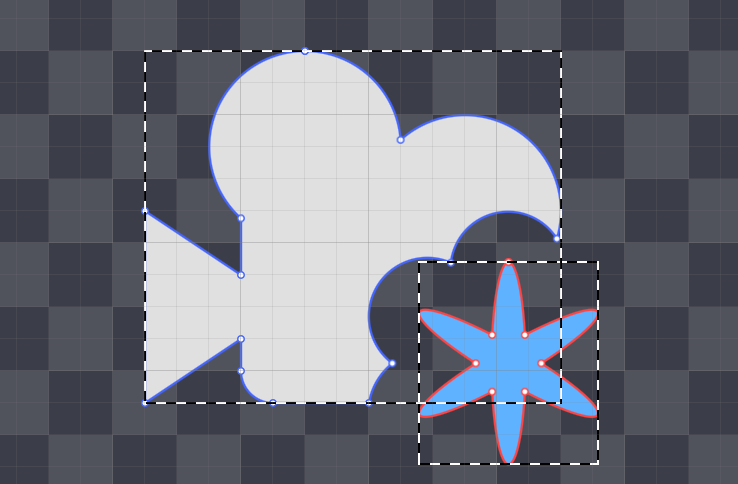Ray marching ocean waves + atmosphere
Original source: https://www.shadertoy.com/view/3lyGDd
Ported from shadertoy as part of my own learning about ray marching. It consists of an ocean (probably based on gerstner wave function since I noticed horizontal-axis motion in waves) redndered using raymarching. And an atmosphere based on rayleigh + mie models.
Shader code
shader_type canvas_item;
const float INFINITY = 999.9e16;
//const float PI = 3.14159265358979323;
const float PHI = 1.61803398874989484820459; // Golden Ratio
const float EARTH_RADIUS = 6360000.0; // in m
const float ATMOSPHERE_RADIUS = 6420000.0; // in m
const float SUN_POWER = 20.0;
const int SKY_SAMPLES = 16;
const int SUN_SAMPLES = 8;
#define SUNTIME (TIME / 2.0)
#define EPSILON_NRM (0.1 / (1024.0))//scren pixel size
const int ITER_GEOMETRY = 3;
const int ITER_FRAGMENT = 5;
const float SEA_HEIGHT = 0.6;
const float SEA_CHOPPY = 2.0;
const float SEA_SPEED = 0.8;
const float SEA_FREQ = 0.16;
const vec3 SEA_BASE = vec3(0.0, 0.09, 0.18);
const vec3 SEA_WATER_COLOR = vec3(0.8, 0.9, 0.6) * 0.6;
const mat2 octave_m = mat2(vec2(1.6, 1.2), vec2(-1.2, 1.6));
const int NUM_STEPS = 8;
float hash(vec2 p) {
return fract(sin(dot(p.xy, vec2(12.9898, 78.233))) * 43758.5453);
}
float noise(vec2 p) {
vec2 i = floor(p);
vec2 f = fract(p);
vec2 u = f * f * (3.0 - 2.0 * f);
return -1.0 + 2.0 * mix(mix(hash(i + vec2(0.0, 0.0)), hash(i + vec2(1.0, 0.0)), u.x),
mix(hash(i + vec2(0.0, 1.0)), hash(i + vec2(1.0, 1.0)), u.x), u.y);
}
float sea_octave(vec2 uv, float choppy) {
uv += noise(uv);
vec2 wv = 1.0 - abs(sin(uv));
vec2 swv = abs(cos(uv));
wv = mix(wv, swv, wv);
return pow(1.0 - pow(wv.x * wv.y, 0.65), choppy);
}
float map(vec3 p) {
float freq = SEA_FREQ;
float amp = SEA_HEIGHT;
float choppy = SEA_CHOPPY;
vec2 uv = p.xz;
uv.x *= 0.75;
float d, h = 0.0;
for (int i = 0; i < ITER_GEOMETRY; i++) {
d = sea_octave((uv + TIME) * freq, choppy);
d += sea_octave((uv - TIME) * freq, choppy);
h += d * amp;
uv *= octave_m;
freq *= 1.9;
amp *= 0.22;
choppy = mix(choppy, 1.0, 0.2);
}
return p.y - h;
}
float map_detailed(vec3 p) {
float freq = SEA_FREQ;
float amp = SEA_HEIGHT;
float choppy = SEA_CHOPPY;
vec2 uv = p.xz;
uv.x *= 0.75;
float d, h = 0.0;
for (int i = 0; i < ITER_FRAGMENT; i++) {
d = sea_octave((uv + TIME) * freq, choppy);
d += sea_octave((uv - TIME) * freq, choppy);
h += d * amp;
uv *= octave_m;
freq *= 1.9;
amp *= 0.22;
choppy = mix(choppy, 1.0, 0.2);
}
return p.y - h;
}
vec3 getNormal(vec3 p, float eps) {
vec3 n;
n.y = map_detailed(p);
n.x = map_detailed(vec3(p.x + eps, p.y, p.z)) - n.y;
n.z = map_detailed(vec3(p.x, p.y, p.z + eps)) - n.y;
n.y = eps;
return normalize(n);
}
float heightMapTracing(vec3 origin, vec3 direction, inout vec3 p) {
float tm = 0.0;
float tx = 1000.0;
float hx = map(origin + direction * tx);
if (hx > 0.0)
return tx;
float hm = map(origin + direction * tm);
float tmid = 0.0;
for (int i = 0; i < NUM_STEPS; i++) {
tmid = mix(tm, tx, hm / (hm - hx));
p = origin + direction * tmid;
float hmid = map(p);
if (hmid < 0.0) {
tx = tmid;
hx = hmid;
} else {
tm = tmid;
hm = hmid;
}
}
return tmid;
}
float diffuse(vec3 n, vec3 l, float p) {
return pow(dot(n, l) * 0.4 + 0.6, p);
}
float specular(vec3 n, vec3 l, vec3 e, float s) {
float nrm = (s + 8.0) / (PI * 8.0);
return pow(max(dot(reflect(e, n), l), 0.0), s) * nrm;
}
bool solveQuadratic(float a, float b, float c, out float t0, out float t1) {
float discrim = b * b - 4.0 * a * c;
if (discrim < 0.0)
return false;
float rootDiscrim = sqrt(discrim);
float q = (b > 0.0) ? -0.5 * (b + rootDiscrim) : -0.5 * (b - rootDiscrim);
t1 = q / a;
t0 = c / q;
return true;
}
bool PlanetSphereIntersect(vec3 origin, vec3 direction, float rad, vec3 pos, inout float t0, inout float t1) {
vec3 L = origin - pos;
float a = dot(direction, direction);
float b = 2.0 * dot(direction, L);
float c = dot(L, L) - (rad * rad);
if (!solveQuadratic(a, b, c, t0, t1))
return false;
float temp;
if (t0 > t1) {
temp = t0;
t0 = t1;
t1 = temp;
}
return true;
}
vec3 calculateSkySphereColor(vec3 origin, vec3 direction, float tmin, float tmax, vec3 sunDirection) {
vec3 earthCenter = vec3(0, -1.0 * EARTH_RADIUS, 0);
vec3 betaR = vec3(3.8e-6, 13.5e-6, 33.1e-6);
vec3 betaM = vec3(21e-6);
float Hr = 7994.0;
float Hm = 1200.0;
float t0, t1;
if (!PlanetSphereIntersect(origin, direction, ATMOSPHERE_RADIUS, earthCenter, t0, t1) || t1 < 0.0)
return vec3(0);
if (t0 > tmin && t0 > 0.0)
tmin = t0;
if (t1 < tmax)
tmax = t1;
float segmentLength = (tmax - tmin) / float(SKY_SAMPLES);
float tCurrent = tmin;
vec3 sumR = vec3(0); // rayleigh contribution
vec3 sumM = vec3(0); // mie contribution
float opticalDepthR = 0.0;
float opticalDepthM = 0.0;
float mu = dot(direction, sunDirection);
float phaseR = 3.0 / (16.0 * PI) * (1.0 + mu * mu);
float g = 0.76;
float phaseM = 3.0 / (8.0 * PI) * ((1.0 - g * g) * (1.0 + mu * mu)) / ((2.0 + g * g) * pow(max(0.0, 1.0 + g * g - 2.0 * g * mu), 1.5));
for (int i = 0; i < SKY_SAMPLES; ++i) {
vec3 samplePosition = origin + (tCurrent) * direction;
float height = length(samplePosition - earthCenter) - EARTH_RADIUS;
float hr = exp(-height / Hr) * segmentLength;
float hm = exp(-height / Hm) * segmentLength;
opticalDepthR += hr;
opticalDepthM += hm;
float t0Light, t1Light;
PlanetSphereIntersect(samplePosition, sunDirection, ATMOSPHERE_RADIUS, earthCenter, t0Light, t1Light);
float segmentLengthLight = t1Light / float(SUN_SAMPLES);
float tCurrentLight = 0.0;
float opticalDepthLightR = 0.0;
float opticalDepthLightM = 0.0;
int jCounter = 0;
for (int j = 0; j < SUN_SAMPLES; ++j) {
vec3 samplePositionLight = samplePosition + (tCurrentLight) * sunDirection;
float heightLight = length(samplePositionLight - earthCenter) - EARTH_RADIUS;
if (heightLight < 0.0)
break;
jCounter += 1;
opticalDepthLightR += exp(-heightLight / Hr) * segmentLengthLight;
opticalDepthLightM += exp(-heightLight / Hm) * segmentLengthLight;
tCurrentLight += segmentLengthLight;
}
if (jCounter == SUN_SAMPLES) {
vec3 tau = betaR * (opticalDepthR + opticalDepthLightR) + betaM * 1.1 * (opticalDepthM + opticalDepthLightM);
vec3 attenuation = vec3(exp(-tau.x), exp(-tau.y), exp(-tau.z));
sumR += attenuation * hr;
sumM += attenuation * hm;
}
tCurrent += segmentLength;
}
vec3 attenuate_vec = (sumR * betaR * phaseR + sumM * betaM * phaseM) * SUN_POWER;
if (attenuate_vec.x < 1.413) {
attenuate_vec.x = pow(attenuate_vec.x * 0.38317, 1.0 / 2.2);
} else {
attenuate_vec.x = 1.0 - exp(-attenuate_vec.x);
}
if (attenuate_vec.y < 1.413) {
attenuate_vec.y = pow(attenuate_vec.y * 0.38317, 1.0 / 2.2);
} else {
attenuate_vec.y = 1.0 - exp(-attenuate_vec.y);
}
if (attenuate_vec.z < 1.413) {
attenuate_vec.z = pow(attenuate_vec.z * 0.38317, 1.0 / 2.2);
} else {
attenuate_vec.z = 1.0 - exp(-attenuate_vec.z);
}
return attenuate_vec;
}
vec3 perspectiveCameraRayDirection(vec2 pixelCoord) {
vec2 pixelPos = (pixelCoord) * 2.0 - 1.0;
vec3 camRight = vec3(1.0, 0.0, 0.0);
vec3 camUp = vec3(0.0, 1.0, 0.0);
vec3 camForward = vec3(0.0, 0.0, 1.0);
return normalize(pixelPos.x * camRight + pixelPos.y * camUp + camForward);
}
vec3 getSeaColor(vec3 p, vec3 n, vec3 l, vec3 eye, vec3 dist) {
float fresnel = clamp(1.0 - dot(n, -eye), 0.0, 1.0);
fresnel = pow(fresnel, 3.0) * 0.5;
vec3 reflected = calculateSkySphereColor(p, reflect(eye, n), 0.0, INFINITY, l);
vec3 base = SEA_BASE * calculateSkySphereColor(p, vec3(1.0), 0.0, INFINITY, l);
vec3 refracted = base + diffuse(n, l, 80.0) * SEA_WATER_COLOR * 0.12;
vec3 color = mix(refracted, reflected, fresnel);
float atten = max(1.0 - dot(dist, dist) * 0.01, 0.0);
color += SEA_WATER_COLOR * (p.y - SEA_HEIGHT) * 0.18 * atten;
color += vec3(specular(n, l, eye, 20.0)) * 0.8 * reflected;
return color;
}
vec4 pixel(vec2 uv) {
vec3 origin = vec3(0.0, 3.0, -15.0);
vec3 direction = perspectiveCameraRayDirection(uv);
vec3 sunDir = normalize(vec3(0, abs(cos(SUNTIME)) / 2.0 - 0.2, abs(sin(SUNTIME)) * 2.0));
vec3 sky = calculateSkySphereColor(origin, direction, 0.0, INFINITY, sunDir);
vec3 p;
heightMapTracing(origin, direction, p);
vec3 dist = p - origin;
vec3 n = getNormal(p, dot(dist, dist) * EPSILON_NRM);
vec3 waves = mix(
sky,
getSeaColor(p, n, sunDir, direction, dist),
pow(smoothstep(0.0, -0.5, direction.y), 0.5));
return vec4(waves, 1.0);
}
void fragment() {
vec2 uv = FRAGCOORD.xy / vec2(1.0/SCREEN_PIXEL_SIZE.x, 1.0/SCREEN_PIXEL_SIZE.y);
uv.y = 1.0 - uv.y; // Invert the y-component
vec2 aa = 0.25 / vec2(1.0/SCREEN_PIXEL_SIZE.x, 1.0/SCREEN_PIXEL_SIZE.y);
vec4 fragColor = pixel(uv);
fragColor += pixel(uv + aa);
fragColor *= 0.5;
COLOR = fragColor;
}

